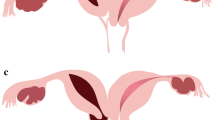Abstract
Objective
To investigate the clinical characteristics and treatment of the Herlyn–Werner–Wunderlich syndrome (HWWS).
Methods
Sixty-one patients diagnosed with HWWS were retrospectively analyzed. HWWS is categorized into three types in China.
Results
Age at presentation of all the cases was after menarche. The most common clinical presentations were dysmenorrhea for type I and vaginal discharge for types II and III. Clinical presentations of types II and III may not occur until reproductive age. HWWS occurred on the right in 39/61. Excision of the obstructed vaginal septum was the treatment utilized in this cohort. After surgery, subsequent pregnancies were ipsilateral in 52.9 %.
Conclusions
Clinical presentation in untreated HWWS suggests the anatomic anomaly. Early recognition and treatment can reduce symptoms. Pregnancies occur in both the affected and unaffected uterus.

Similar content being viewed by others
References
Orazi C, Lucchetti MC, Schingo PMS et al (2007) Herlyn–Werner–Wunderlich syndrome: uterus didelphys, blinding hemivagina and ipsilateral renal agenesis. Sonographic and MR findings in 11 cases. Pediatr Radiol 37:657–665
Purslow CE (1922) A case of unilateral haematocolpos, haematometra and haematosalpinx. J Obstet Gynaecol Br Emp 29:643
Bian ML, Huang RL, Wu BZ, Lian LJ, Song HZ (1985) Oblique vaginal septum: report of 15 cases. Zhonghua Fu Chan Ke Za Zhi 20(2):85–88
O’Neill MJ, Yoder IC, Connolly SA, Mueller PR (1999) Imaging evaluation and classification of developmental anomalies of the female reproductive system with an emphasis on MR imaging. AJR Am J Roentgenol 173(2):407–416
Takagi H, Matsunami K, Imai A (2010) Uterovaginal duplication with blind hemivagina and ipsilateral renal agenesis: review of unusual presentation. J Obstet Gynaecol 30(4):350–353
Hur JY, Shin JH, Lee JK, Oh MJ, Saw HS, Park YK, Lee KW (2007) Septate uterus with double cervices, unilaterally obstructed vaginal septum, and ipsilateral renal agenesis: a rare combination of müllerian and wolffian anomalies complicated by severe endometriosis in an adolescent. J Minim Invasive Gynecol 14(1):128–131
Kimble RMN, Khoo SK, Baatrz D, Kimble RM (2009) The obstructed hemivagina, ipsilateral renal anomaly, uterus didelphys triad. Aust N Z J Obstet Gynaecol 49:554–557
Tsai EM, Chiang PH, Hsu SC, Su JH, Lee JN (1998) Hysteroscopic resection of vaginal septum in an adolescent virgin with obstructed hemivagina. Hum Reprod 13(6):1500–1501
Rock JA, Jones HWJ (1980) The double uterus associated with an obstructed hemivagina and ipsilateral renal agenesis. Am J Obstet Gynecol 138:339–342
Morgan MA, Thurnau GR, Smith ML (1987) Uterus didelphys with hematocolpos, ipsilateral renal agenesis and menses. A case report and literature review. J Reprod Med 32:47–58
Haddad B, Barranger E, Paniel B (1999) Blind hemivagina: long-term follow-up and reproductive performance in 42 cases. Hum Reprod 14(8):1962–1964
Vercellini P, Daguati R, Somigliana E, Viganò P, Lanzani A, Fedele L (2007) Asymmetric lateral distribution of obstructed hemivagina and renal agenesis in women with uterus didelphys: institutional case series and a systematic literature review. Fertil Steril 87(4):719–724
Acknowledgments
Thanks Li-Hong Zhu for her revising for this manuscript. Thanks Prof. Jia-Xin Yang and associate Prof. Zheng-Yi Sun for providing sketch for Fig. 1.
Conflict of interest
None.
Author information
Authors and Affiliations
Corresponding author
Rights and permissions
About this article
Cite this article
Wang, J., Zhu, L., Lang, J. et al. Clinical characteristics and treatment of Herlyn–Werner–Wunderlich syndrome. Arch Gynecol Obstet 290, 947–950 (2014). https://doi.org/10.1007/s00404-014-3286-5
Received:
Accepted:
Published:
Issue Date:
DOI: https://doi.org/10.1007/s00404-014-3286-5




